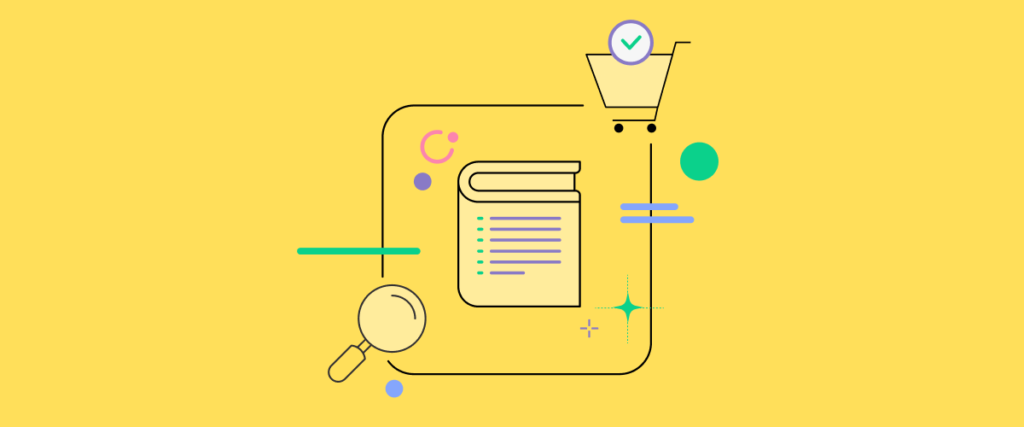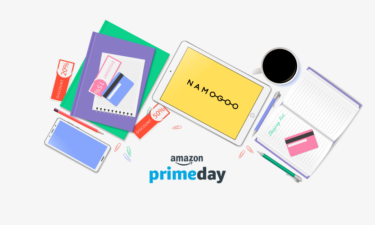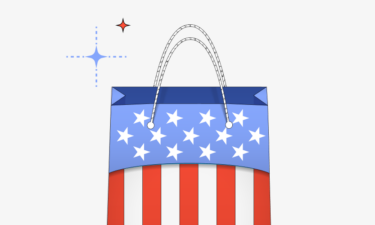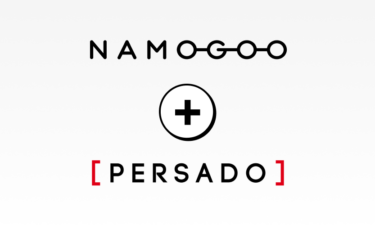The eCommerce space is full of confusing terms and acronyms. Injected ads, CRO, AOV — it’s easy to get overwhelmed.
This eCommerce dictionary simplifies the most common terms in easy-to-understand definitions so you can stay laser-focused on driving sales — instead of getting lost down an internet rabbit hole.
The Complete eCommerce Dictionary
This is a living eCommerce dictionary of every single term you might need to know when you’re operating an online store.
A/B Testing
A/B testing is a method that compares two versions of a website, landing page, or paid ad to determine which drives the most results. Also called split testing, it shows site visitors one of two variations at random and tracks which version results in the most clicks, conversions, or sales.
For example, a site might use A/B testing to determine whether a blue “buy now” button or an orange “buy now” button results in more sales. Unlike multi-variate testing, which can use three or more versions, A/B testing only uses two variations.
Learn more: The Ultimate Guide to A/B Testing
Average Order Value
Average order value, also referred to as AOV, is a commonly-reported eCommerce metric that measures how much each order is worth over a period of time.
The formula for average order value divides the total value of all orders over a period of time by the total number of orders over the same period.
Learn more: Average Order Value: The Advanced Guide
Behavioral Segmentation
Behavioral segmentation is the practice of separating or grouping customers based on behaviors they have in common. For example, segmenting an email list into current and prospective customers.
Behavioral segmentation improves the effectiveness of marketing campaigns, such as email marketing, by allowing brands to send more targeted messages.
Learn more: Behavioral Segmentation: Using Data to Craft the Perfect Customer Experience
Bounce Rate
Bounce rate is a website analytics metric that measures the percentage of site visitors who visit a page and do not complete any action on the site before leaving. In your analytics programs, the bounce rate only counts visitors who visit one page on the site.
A high bounce rate can highlight issues with your marketing or site design. For example, it may mean a site doesn’t work well on mobile devices, or the content doesn’t match the user’s expectations.
Learn more: Bounce Rate vs Exit Rate: Which Should I Improve?
Brand Equity
The value and worth of a brand itself, i.e., the value consumers associate with a specific name brand. Brands that are easily recognizable and trusted have higher brand equity with consumers.
For example, when Apple releases a new iPhone, most consumers trust it will be well-made and technologically advanced. This is a result of Apple’s brand equity.
Brand Perception
Brand perception refers to the sum of all feelings, thoughts, and perceptions customers have about a brand. It can include brand awareness, brand equity, loyalty, and emotional attachment to the brand.
Brand perception is often measured with a brand perception survey.
Call to Action
Call-to-action, also called a CTA, is a prompt that encourages users to take the next step in a sales or conversion funnel. It generally refers to a sentence or statement that tells the customers precisely what to do — for example, “Get started with a free trial,” or “Get yours now.”
Cart Abandonment
Also called shopping cart abandonment, cart abandonment measures the rate at which users add an item to their digital shopping cart and fail to complete their purchase.
A high cart abandonment rate can result from high shipping rates, lack of trust signals, or an overly complex check-out process.
Learn more: Digital Shopping Cart Abandonment: A Data-Driven Guide
Conversion Funnel
The conversion funnel refers to the journey a customer takes from first becoming aware of your brand to conversion. In eCommerce, this process generally includes awareness, interest, desire, and action stages.
Conversion funnels are often split into three portions — top, middle, and bottom. Each portion of the funnel requires different strategies, content, and techniques.
Conversion Rate
Conversion rate is a metric that tracks what percentage of site visitors complete a desired outcome. It is calculated by dividing the number of conversions by the number of site visitors.
Conversion Rate Optimization
Conversion rate optimization, often called CRO, is the practice of implementing site changes to increase the number of site visitors that complete a desired action. Common CRO strategies include A/B testing headlines, streamlining the check-out process, and testing the number of fields in a form.
CRO is crucial to lowering customer acquisition costs and improving the effectiveness of market strategies.
Learn more: Conversion Rate Optimization Archive
Customer Journey
Customer journey is a visual representation of the steps a user takes from first learning about a product or brand to conversion. Writing down the entire process helps eCommerce stores locate bottlenecks in the process, improve marketing effectiveness, and increase ROI.
Steps in the customer journey process may include awareness, search, reputation, conversion, experience.
Customer Journey Hijacking
Customer journey hijacking, also called CJH, occurs when unauthorized ads are injected into user’s browsers, including popups, banners, and text ads. These ads distract users from your site, pulling them out of the customer journey and redirecting them to your competitors.
The end result is lower conversion rates, higher acquisition rates, and fewer sales.
Learn more: Customer Journey Hijacking Prevention
Customer Lifetime Value
Often shortened to CLV or LTV, this measures the amount of money a customer is likely to spend over the course of their relationship with a brand, not just the first purchase they make. This metric is calculated by multiplying the average order total by the average number of purchases in a year multiplied by the average length of retention.
Learn more: Is This the Most Important Secret for Increasing Lifetime Value?
Customer Segmentation
Customer segmentation, also called marketing segmentation, divides customers into smaller groups with similar demographics, interests, or behaviors.
Segmentation allows brands to target customers more effectively by creating more targeted marketing campaigns. For example, you might create a segment for college-age customers and send them a summer email promoting back to college supplies.
Learn more: Customer Segmentation: The Definitive Guide
Demographic Segmentation
Demographic segmenting is a type of customer segmentation that buckets an audience based on demographic information, including age, race, gender, family status, income, education level, employment, and occupation. Each demographic segment can also be broken down into subgroups.
Demographic segmentation breaks consumers into groups based on who they are, unlike behavioral segmentation, which separates visitors based on their actions.
Learn more: Demographic Segmentation: A Complete Guide for eCommerce Brands (with Examples)
Discounting Rate
Discounting rate is an eCommerce metric that calculates the level of discount required to increase conversions. A higher discounting rate results in lower profit margins, so understanding the exact discount required to encourage conversion is crucial.
eCommerce Metrics
eCommerce metrics are quantifiable, measurable data points that help eCommerce brands understand which marketing strategies are most effective. Common eCommerce metrics include conversion rate, average order value, customer retention rate, customer acquisition costs, click-through rates, and shopping cart abandonment rates.
Friction Points
Friction points refer to variables in the customer journey or conversion funnel that slow down or stop progression through the sales funnel. Examples of friction points include out-of-stock products, unclear ad or landing page copy, or slow load times.
Learn more: 4 Proven Ways to Optimize Your eCommerce Checkout Process
Injected Ads
Injected ads are ads added to websites via browser extensions. These ads are sold to third parties, generally without the site owner’s knowledge. They are especially problematic for eCommerce sites because they may display competitor products and can hijack customers from your site.
For example, Target.com might inject ads for its products on Walmart’s website to pull customers away from Walmart’s site.
Learn more: How to Prevent Injected Ads from Stealing Your Online Shoppers
Intent Signals
Intent signals show a customer is interested in a specific type of product or is ready to make a purchase. Tracking these signals helps eCommerce stores create intent-based promotions, which target customers who are closer to conversion.
Learn more: Customer Purchase Intention: Definition, Why (+ How) to Measure & Convert
Intent-Based Marketing
Intent-based marketing is a strategy that specifically targets consumers who have displayed intent to purchase. Because it targets consumers further in the purchase funnel, it is often more effective.
Learn more: Customer Purchase Intention: Definition, Why (+ How) to Measure & Convert
Micro Conversions
Micro conversions refer to small actions users take on your site that lead them towards your main conversion. Tracking micro conversions provides insight into how consumers engage with your website and move through the sales funnel.
For example, your macro conversion may be a sale. Before that occurs, however, you may want to know how many site visitors download an ebook, read a buyer’s guide, or click on a category page.
Perceived Value
Perceived value suggests that eCommerce success is based on whether a customer thinks a product’s benefits exceed its cost. Perceived value is closely related to value proposition, and includes traits such as performance, branding, and pricing.
Learn more: The Psychology of Discounts: 8 Research-Backed Strategies for 2021
Persistent Carts
To safeguard against cart abandonment and to support cart recovery strategies, many eCommerce platforms offer persistent carts, which use cookies to save digital shopping cart additions.
This allows customers to return to their cart as long as they are on the same device.
Personalized Marketing
Personalized marketing, also called individualized marketing, is a marketing strategy that uses behavioral and demographic data to deliver customized content, ads, and other materials to current or prospective customers. Examples of personalized marketing include dynamic ads, targeted emails, and custom product recommendations.
Pivotal Moment
In marketing, a pivotal moment refers to a tipping point in the conversion process. The pivotal moment can refer to several events, such as when a customer decides which product to buy or when a customer moves from the research stage to the purchase stage.
Understanding where the pivotal moment is in a sales funnel helps brands understand where to focus time and resources.
Learn More: Harness the Power of the Pivotal Moment
Psychographic Segmentation
Psychographic segmentation is a segmentation technique that sorts prospective customers into segments based on physiological traits that impact buying behavior, such as interests, social status, lifestyle, and personality.
Unlike demographic segmentation, which sorts prospects based on who they are, psychographic segmentation sorts potential customers based on their specific actions and psychological makeup. For example, targeting high-earning, urban parents for a luxury car seat.
Learn More: Psychographic Segmentation in 2021: Definition, Benefits, & Types
Revenue Per Visitor
Revenue per visitor, often shortened to RPV, measures the value of each visitor to your site. It is calculated by dividing the total revenue of a website or page by the number of visitors. RPV can help estimate the value of additional traffic or diagnose issues in the sales process.
For example, if your site earns $1,000 in revenue a month but has a million visitors, it indicates a large portion of your site visitors are not finding what they want.
Learn More: Revenue Per Visitor: RPV Formula + How to Improve It
Sales Promotion Strategy
A sales promotion strategy is a defined plan to increase the effectiveness of a sales or discount program. For example, a free gift promotion is likely to be more effective if your customers know about it, so your strategy might include an email marketing campaign, Facebook ads, and a popup about the upcoming promotion.
Learn more: Sales Promotion Strategy: How to Build a Promo Plan to Drive Growth
Sales Promotions
Sales promotions are an eCommerce strategy aimed at increasing sales and brand awareness by offering a discount or promotion. Examples include free shipping, flash sales, seasonal campaigns, and new subscriber discounts.
Learn more: 12 Sales Promotion Examples that Convert
Social Proof
In marketing, social proof refers to the impact of word-of-mouth marketing (both online and in-person) on buying behavior. For example, a consumer is more likely to purchase an item with positive online reviews.
Trust Signals
Trust signals are a collection of signals that increase trust in a website or business. For eCommerce brands, trust signals include an SSL certificate, social proof like online reviews, having a Facebook page, or logos of current customers.
User Experience
User experience, also referred to as UX, refers to design decisions that impact how a user interacts with a website, platform, or service. It includes factors such as ease of use, efficiency, and functionality. Improving UX makes it easier for visitors to navigate your site and complete their purchase.








